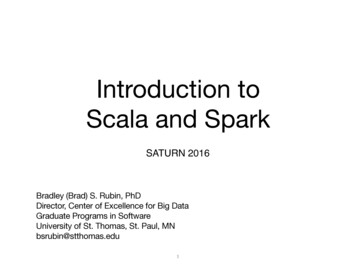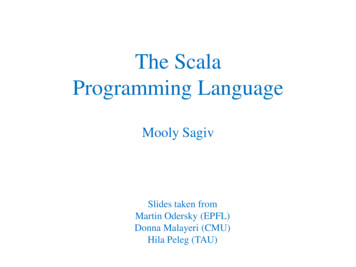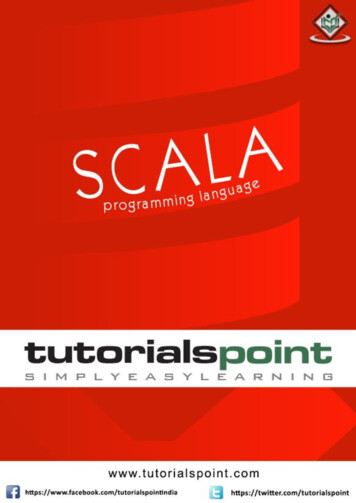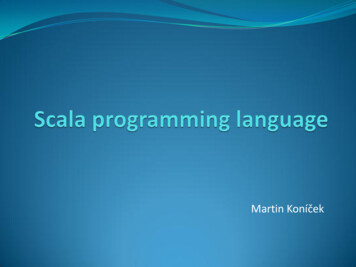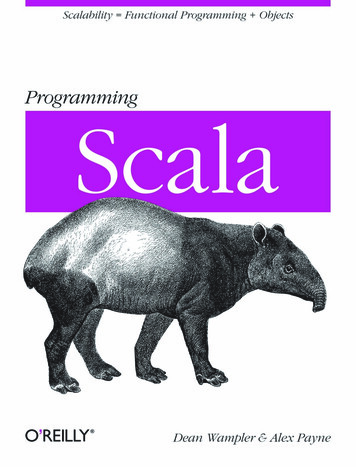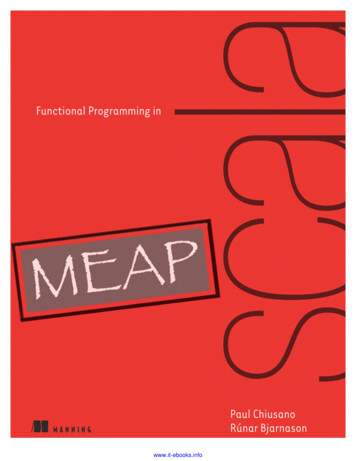
Transcription
www.it-ebooks.info
MEAP EditionManning Early Access ProgramFunctional Programming in Scalaversion 10Copyright 2013 Manning PublicationsFor more information on this and other Manning titles go towww.manning.comwww.it-ebooks.info
brief contentsPART 1: INTRODUCTION TO FUNCTIONAL PROGRAMMING1. What is functional programming?2. Getting Started3. Functional data structures4. Handling errors without exceptions5. Strictness and laziness6. Purely functional statePART 2: FUNCTIONAL DESIGN AND COMBINATOR LIBRARIES7. Purely functional parallelism8. Property-based testing9. Parser combinatorsPART 3: FUNCTIONAL DESIGN PATTERNS10. Monoids11. Monads12. Applicative and traversable functorsPART 4: BREAKING THE RULES: EFFECTS AND I/O13. External effects and I/O14. Local effects and the ST monad15. Stream processing and incremental I/Owww.it-ebooks.info
1PPrefaceP.1 About this bookThis is not a book about Scala. This book introduces the concepts and techniquesof functional programming (FP)—we use Scala as the vehicle, but the lessonsherein can be applied to programming in any language. Our goal is to give you thefoundations to begin writing substantive functional programs and to comfortablyabsorb new FP concepts and techniques beyond those covered here. Throughoutthe book we rely heavily on programming exercises, carefully chosen andsequenced to guide you to discover FP for yourself. Expository text is often justenough to lead you to the next exercise. Do these exercises and you will learn thematerial. Read without doing and you will find yourself lost.A word of caution: no matter how long you've been programming, learning FPis challenging. Come prepared to be a beginner once again. FP proceeds from astartling premise—that we construct programs using only pure functions, orfunctions that avoid side effects like writing to a database or reading from a file. Inthe first chapter, we will explain exactly what this means. From this single idea andits logical consequences emerges a very different way of building programs, onewith its own body of techniques and concepts. We start by relearning how to writethe simplest of programs in a functional way. From this foundation we will buildthe tower of techniques necessary for expressing functional programs of greatercomplexity. Some of these techniques may feel alien or unnatural at first and theexercises and questions can be difficult, even brain-bending at times. This isnormal. Don't be deterred. Keep a beginner's mind, try to suspend judgment, and ifwww.it-ebooks.info
2you must be skeptical, don't let this skepticism get in the way of learning. Whenyou start to feel more fluent at expressing functional programs, then take a stepback and evaluate what you think of the FP approach.This book does not require any prior experience with Scala, but we won't spenda lot of time and space discussing Scala's syntax and language features. Insteadwe'll introduce them as we go, with a minimum of ceremony, mostly using shortexamples, and mostly as a consequence of covering other material. These minimalintroductions to Scala should be enough to get you started with the exercises. Ifyou have further questions about the Scala language while working on theexercises, you are expected to do some research and experimentation on your ownor follow some of our links to further reading.P.2 How to read this bookThe book is organized into four parts, intended to be read sequentially. Part 1introduces functional programming, explains what it is, why you should care, andwalks through the basic low-level techniques of FP, including how to organize andstructure small functional programs, define functional data structures, and handleerrors functionally. These techniques will be used as the building blocks for allsubsequent parts. Part 2 introduces functional design using a number of workedexamples of functional libraries. It will become clear that these libraries followcertain patterns, which highlights the need for new cognitive tools for abstractingand generalizing code—we introduce these tools and explore concepts related tothem in Part 3. Building on Part 3, Part 4 covers techniques and mechanisms forwriting functional programs that perform I/O (like reading/writing to a database,files, or the screen) or writing to mutable variables.Though the book can be read sequentially straight through, the material in Part3 will make the most sense after you have a strong familiarity with the functionalstyle of programming developed over parts 1 and 2. After Part 2, it may thereforebe a good idea to take a break and try getting more practice writing functionalprograms beyond the shorter exercises we work on throughout the chapters. Part 4also builds heavily on the ideas and techniques of Part 3, so a second break afterPart 3 to get experience with these techniques in larger projects may be a good ideabefore moving on. Of course, how you read this book is ultimately up to you, andyou are free to read ahead if you wish.Most chapters in this book have similar structure. We introduce and explainsome new idea or technique with an example, then work through a number ofexercises, introducing further material via the exercises. The exercises thus servewww.it-ebooks.info
3two purposes: to help you to understand the ideas being discussed and to guide youto discover for yourself new ideas that are relevant. Therefore we strongly suggestthat you download the exercise source code and do the exercises as you go througheach chapter. Exercises, hints and answers are all available athttps://github.com/pchiusano/fpinscala. We also encourage you to visit thescala-functional Google group and the #fp-in-scala IRC channel onirc.freenode.net for questions and discussion.Exercises are marked for both their difficulty and to indicate whether they arecritical or noncritical. We will mark exercises that we think are hard or that weconsider to be critical to understanding the material. The hard designation is oureffort to give you some idea of what to expect—it is only our guess and you mayfind some unmarked questions difficult and some questions marked hard to bequite easy. The critical designation is applied to exercises that address conceptsthat we will be building on and are therefore important to understand fully.Noncritical exercises are still informative but can be skipped without impedingyour ability to follow further material.Examples are given throughout the book and they are meant to be tried ratherthan just read. Before you begin, you should have the Scala interpreter (REPL)running and ready. We encourage you to experiment on your own with variationsof what you see in the examples. A good way to understand something is to changeit slightly and see how the change affects the outcome.Sometimes we will show a REPL session to demonstrate the result of runningsome code. This will be marked by lines beginning with the scala prompt ofthe REPL. Code that follows this prompt is to be typed or pasted into theinterpreter, and the line just below will show the interpreter's response, like this:scala println("Hello, World!")Hello, World!SIDEBARSidebarsOccasionally throughout the book we will want to highlight the precisedefinition of a concept in a sidebar like this one. This lets us give you acomplete and concise definition without breaking the flow of the maintext with overly formal language, and also makes it easy to refer back towhen needed.There are chapter notes (which includes references to external resources) andwww.it-ebooks.info
4several appendix chapters after Part 4. Throughout the book we provide referencesto this supplementary material, which you can explore on your own if that interestsyou.Have fun and good luck.www.it-ebooks.info
51What is Functional Programming?1.1 The fundamental premise of functional programmingFunctional programming (FP) is based on a simple premise with far-reachingimplications: We construct our programs using only pure functions. In other words,functions that have no side effects. What does this mean exactly? Performing anyof the following actions directly would involve a side effect:Reassigning a variableModifying a data structure in placeSetting a field on an objectThrowing an exception or halting with an errorPrinting to the console or reading user inputReading from or writing to a fileDrawing on the screenConsider what programming would be like without the ability to do thesethings. It may be difficult to imagine. How is it even possible to write usefulprograms at all? If we can't reassign variables, how do we write simple programslike loops? What about working with data that changes, or handling errors withoutthrowing exceptions? How can we perform I/O, like drawing to the screen orreading from a file?The answer is that we can still write all of the same programs—programs thatcan do all of the above and more—without resorting to side effects. Functionalprogramming is a restriction on how we write programs, but not on what programswe can write. And it turns out that accepting this restriction is tremendouslywww.it-ebooks.info
6beneficial because of the increase in modularity that we gain from programmingwith pure functions. Because of their modularity, pure functions are easier to test,to reuse, to parallelize, to generalize, and to reason about.But reaping these benefits requires that we revisit the act of programming,starting from the simplest of tasks and building upward from there. In many caseswe discover how programs that seem to necessitate side effects have some purelyfunctional analogue. In other cases we find ways to structure code so that effectsoccur but are not observable (For example, we can mutate data that is declaredlocally in the body of some function if we ensure that it cannot be referencedoutside that function.) Nevertheless, FP is a truly radical shift in how programs areorganized at every level—from the simplest of loops to high-level programarchitecture. The style that emerges is quite different, but it is a beautiful andcohesive approach to programming that we hope you come to appreciate.In this book, you will learn the concepts and principles of FP as they apply toevery level of programming. We begin in this chapter by explaining what a purefunction is, as well as what it isn't. We also try to give you an idea of just whypurity results in greater modularity and code reuse.1.2 Exactly what is a (pure) function?A function with input type A and output type B (written in Scala as a single type: A B) is a computation which relates every value a of type A to exactly one valueb of type B such that b is determined solely by the value of a.For example, a function intToString having type Int String willtake every integer to a corresponding string. Furthermore, if it really is a function,it will do nothing else.In other words, a function has no observable effect on the execution of theprogram other than to compute a result given its inputs; we say that it has no sideeffects. We sometimes qualify such functions as pure functions to make this moreexplicit. You already know about pure functions. Consider the addition ( )function on integers. It takes two integer values and returns an integer value. Forany two given integer values it will always return the same integer value. Anotherexample is the length function of a String in Java, Scala, and many otherlanguages. For any given string, the same length is always returned and nothingelse occurs.We can formalize this idea of pure functions by using the concept of referentialtransparency (RT). This is a property of expressions in general and not justwww.it-ebooks.info
7functions. For the purposes of our discussion, consider an expression to be any partof a program that can be evaluated to a result, i.e. anything that you could type intothe Scala interpreter and get an answer. For example, 2 3 is an expression thatapplies the pure function to the values 2 and 3 (which are also expressions). Thishas no side effect. The evaluation of this expression results in the same value 5every time. In fact, if you saw 2 3 in a program you could simply replace itwith the value 5 and it would not change a thing about your program.This is all it means for an expression to be referentially transparent—in anyprogram, the expression can be replaced by its result without changing the meaningof the program. And we say that a function is pure if its body is RT, assuming RTinputs.SIDEBARReferential transparency and purityAn expression e is referentially transparent if for all programs p, alloccurrences of e in p can be replaced by the result of evaluating e,without affecting the observable behavior of p. A function f is pure if theexpression f(x) is referentially transparent for all referentiallytransparent x.1Footnote 1mThere are some subtleties to this definition, and we'll berefinining it later in this book. See the chapter notes for more discussion.1.3 Functional and non-functional: an exampleReferential transparency enables a mode of reasoning about program evaluationcalled the substitution model. When expressions are referentially transparent, wecan imagine that computation proceeds very much like we would solve analgebraic equation. We fully expand every part of an expression, replacing allvariables with their referents, and then reduce it to its simplest form. At each stepwe replace a term with an equivalent one; we say that computation proceeds bysubstituting equals for equals. In other words, RT enables equational reasoningabout programs. This style of reasoning is extremely natural; you use it all the timewhen understanding programs, even in supposedly "non-functional" languages.Let's look at two examples—one where all expressions are RT and can bereasoned about using the substitution model, and one where some expressionsviolate RT. There is nothing complicated here, part of our goal is to illustrate thatwe are just formalizing something you already likely understand on some level.Let's try the following in the Scala REPL:2www.it-ebooks.info
8Footnote 2mIn Java and in Scala, strings are immutable. If you wish to "modify" a string, you must create acopy of it.scala val x "Hello, World"x: java.lang.String Hello, Worldscala val r1 x.reverser1: String dlroW ,olleHscala val r2 x.reverser2: String dlroW ,olleHSuppose we replace all occurrences of the term x with the expressionreferenced by x (its definition), as follows:scala val r1 "Hello, World".reverser1: String dlroW ,olleHval r2 "Hello, World".reverser2: String dlroW ,olleHThis transformation does not affect the outcome. The values of r1 and r2 arethe same as before, so x was referentially transparent. What's more, r1 and r2 arereferentially transparent as well, so if they appeared in some other part of a largerprogram, they could in turn be replaced with their values throughout and it wouldhave no effect on the program.Now let's look at a function that is not referentially transparent. Consider theappend function on the scala.collection.mutable.StringBuilderclass. This function operates on the StringBuilder in place. The previous stateof the StringBuilder is destroyed after a call to append. Let's try this out:scala val x new StringBuilder("Hello")x: java.lang.StringBuilder Helloscala val y x.append(", World")y: java.lang.StringBuilder Hello, Worldscala val r1 y.toStringr1: java.lang.String Hello, Worldscala val r2 y.toStringr2: java.lang.String Hello, Worldwww.it-ebooks.info
9So far so good. Let's now see how this side effect breaks RT. Suppose wesubstitute the call to append like we did earlier, replacing all occurrences of ywith the expression referenced by y:scala val x new StringBuilder("Hello")x: java.lang.StringBuilder Helloscala val r1 x.append(", World").toStringr1: java.lang.String Hello, Worldscala val r2 x.append(", World").toStringr2: java.lang.String Hello, World, WorldThis transformation of the program results in a different outcome. We thereforeconclude that StringBuilder.append is not a pure function. What's going onhere is that while r1 and r2 look like they are the same expression, they are infact referencing two different values of the same StringBuilder. By the timer2 calls x.append, r1 will have already mutated the object referenced by x. Ifthis seems difficult to think about, that's because it is. Side effects make reasoningabout program behavior more difficult.Conversely, the substitution model is simple to reason about since effects ofevaluation are purely local (they affect only the expression being evaluated) andwe need not mentally simulate sequences of state updates to understand a block ofcode. Understanding requires only local reasoning. Even if you haven't used thename "substitution model", you have certainly used this mode of reasoning whenthinking about your code.3Footnote 3mIn practice, programmers don't spend time mechanically applying substitution to determine ifcode is pure—it will usually be quite obvious.1.4 Why functional programming?We said that applying the discipline of FP buys us greater modularity. Why is thisthe case? Though this will become more clear over the course of the book, we cangive some initial insight here.A modular program consists of components that can be understood and reusedindependently of the whole, such that the meaning of the whole depends only onthe meaning of the components and the rules governing their composition; that is,they are composable. A pure function is modular and composable because itseparates the logic of the computation itself from "what to do with the result" andwww.it-ebooks.info
10"how to obtain the input"; it is a black box. Input is obtained in exactly one way:via the argument(s) to the function. And the output is simply computed andreturned. By keeping each of these concerns separate, the logic of the computationis more reusable; we may reuse the logic wherever we want without worryingabout whether the side effect being done with the result or the side effect beingdone to request the input is appropriate in all contexts. We also do not need tomentally track all the state changes that may occur before or after our function'sexecution to understand what our function will do; we simply look at the function'sdefinition and substitute the arguments into its body.Let's look at a case where factoring code into pure functions helps with reuse.This is a simple and contrived example, intended only to be illustrative. Supposewe are writing a computer game and are required to do the following:If player 1's score property is greater than player 2's, notify the user that player1 has won, otherwise notify the user that player 2 has won.We may be tempted to write something like this:case class Player(name: String, score: Int)def printWinner(p: Player): Unit println(p.name " is the winner!")def declareWinner(p1: Player, p2: Player): Unit if (p1.score p2.score) printWinner(p1)else printWinner(p2)Declares a data type Player with two properties: name, which is a string, and score,an integer.Prints the name of the winner to the console.Takes two Players, compares their scores and declares the winner.This declares a simple data type Player with two properties, name, which isa character string, and score which is an integer. The method declareWinnertakes two Players, compares their scores and declares the player with the higherscore the winner (unfairly favoring the second player, granted). TheprintWinner method prints the name of the winner to the console. The resulttype of these methods is Unit indicating that they do not return a meaningfulresult but have a side effect instead.Let's test this in the REPL:scala val sue Player("Sue", 7)sue: Player Player(Sue, 7)www.it-ebooks.info
11scala val bob Player("Bob", 8)bob: Player Player(Bob, 8)scala winner(sue, bob)Bob is the winner!While this code closely matches the earlier problem statement, it alsointertwines the branching logic with that of displaying the result, which makes thereuse of the branching logic difficult. Consider trying to reuse thedeclareWinner method to compute and display the sole winner among nplayers instead of just two. In this case, the comparison logic is simple enough thatwe could just inline it, but then we are duplicating logic—what happens whenplaytesting reveals that our game unfairly favors one player, and we have to changethe logic for determining the winner? We would have to change it in two places.And what if we want to use that same logic to sort a historical collection of pastplayers to display a high score list?Suppose we refactor the code as follows:def winner(p1: Player, p2: Player): Player if (p1.score p2.score) p1 else p2def declareWinner(p1: Player, p2: Player): Unit printWinner(winner(p1, p2))A pure function that takes two players and returns the higher-scoring one.This version separates the logic of computing the winner from the displaying ofthe result. Computing the winner in winner is referentially transparent and theimpure part—displaying the result—is kept separate in printWinner. We cannow reuse the logic of winner to compute the winner among a list of players:val players List(Player("Sue", 7),Player("Bob", 8),Player("Joe", 4))val p players.reduceLeft(winner)printWinner(p)Constructs a list of playerswww.it-ebooks.info
12Reduces the list to just the player with the highest score.Prints the name of the winner to the console.In this example, reduceLeft is a function on the List data type from thestandard Scala library. The expression will compare all the players in the list andreturn the one with the highest score. Note that we are actually passing ourwinner function to reduceLeft as if it were a regular value. We will have a lotmore to say about passing functions to functions, but for now just observe thatbecause winner is a pure function, we are able to reuse it and combine it withother functions in ways that we didn't necessarily anticipate. In particular, thisusage of winner would not have been possible when the side effect of displayingthe result was interleaved with the logic for computing the winner.This was just a simple example, meant to be illustrative, and the sort offactoring we did here is something you've perhaps done many times before. It'sbeen said that functional programming, at least in small examples, is just normalseparation of concerns and "good software engineering".We will be taking the idea of FP to its logical endpoint in this book, andapplying it in situations where is applicability is less obvious. As we'll learn, anyfunction with side effects can be split into a pure function at the "core" andpossibly a pair of functions with side effects; one on the input side, and one on theoutput side. This is what we did when we separated the declaration of the winnerfrom our pure function winner. This transformation can be repeated to push sideeffects to the "outer layers" of the program. Functional programmers often speak ofimplementing programs with a pure core and a thin layer on the outside thathandles effects. We will return to this principle again and again throughout thebook.1.5 ConclusionIn this chapter, we introduced functional programming and explained exactly whatFP is and why you might use it. In subsequent chapters, we cover some of thefundamentals—how do we write loops in FP? Or implement data structures? Howdo we deal with errors and exceptions? We need to learn how to do these thingsand get comfortable with the low-level idioms of FP. We'll build on thisunderstanding when we explore functional design techniques in parts 2 and 3.www.it-ebooks.info
13Index Termscompositionequals for equalsequational reasoningexpression substitutionmodularityprogram modularityreferential transparencyside effectssubstitutionsubstitution modelwww.it-ebooks.info
142Getting started2.1 IntroductionNow that we have committed to using only pure functions, a question naturallyemerges: how do we write even the simplest of programs? Most of us are used tothinking of programs as sequences of instructions that are executed in order, whereeach instruction has some kind of effect. In this chapter we will learn how to writeprograms in the Scala language just by combining pure functions.This chapter is mainly intended for those readers who are new to Scala, tofunctional programming, or both. As with learning a foreign language, immersionis a very effective method, so we will start by looking at a small but completeScala program. If you have no experience with Scala, you should not expect tounderstand the code at first glance. Therefore we will break it down piece by pieceto look at what it does.We will then look at working with higher-order functions. These are functionsthat take other functions as arguments, and may themselves return functions astheir output. This can be brain-bending if you have a lot of experienceprogramming in a language without the ability to pass functions around like that.Remember, it's not crucial that you internalize every single concept in this chapter,or solve every exercise. In fact, you might find it easier to skip whole sections andspiral back to them when you have more experience onto which to attach theseconcepts.2.2 An example Scala programThe following is a complete program listing in Scala.// A comment!www.it-ebooks.info
15/* Another comment *//** A documentation comment */object MyModule {def abs(n: Int): Int if (n 0) -nelse nprivate def formatAbs(x: Int) {val msg "The absolute value of %d is %d"msg.format(x, abs(x))}def main(args: Array[String]): Unit println(formatAbs(-42))}We declare an object (also known as a "module") named MyModule. This issimply to give our code a place to live, and a name for us to refer to it later. Theobject keyword creates a new singleton type, which means that MyModule isthe only value (or 'inhabitant') of that type. We put our code inside the object,between curly braces. We will discuss objects, modules, and namespaces in moredetail shortly. For now, let's just look at this particular object.The MyModule object has three methods: abs, formatAbs, and main.Each method is introduced by the def keyword, followed by the name of themethod which is followed by the arguments in parentheses. In this case all threemethods take only one argument. If there were more arguments they would beseparated by commas. Following the closing parenthesis of the argument list, anoptional type annotation indicates the type of the result (the colon is pronounced"has type").The body of the method itself comes after an equals ( ) sign. We willsometimes refer to the part of a method declaration that goes before the equals signas the left-hand side or signature, and the code that comes after the equals sign wewill sometimes refer to as the right-hand side or definition. Note the absence of anexplicit return keyword. The value returned from a method is simply the valueof its right-hand side.Let's now go through these methods one by one. The abs method represents apure function that takes an integer and returns its absolute value:1Footnote 1mAstute readers might notice that this definition won't work for Integer.MinValue, thesmallest negative 32-bit integer, which has no corresponding positive Int. We'll ignore this technicality here.def abs(n: Int): Int www.it-ebooks.info
16if (n 0) -nelse nThe abs method takes a single argument n of type Int, and this is declared with n:Int.The definition is a single Scala expression that uses the built-in if syntax to negaten if it's less than zero.The formatAbs method represents another pure function:private def formatAbs(x: Int) {val msg "The absolute value of %d is %d."msg.format(x, abs(x))}The format method is a standard library method defined on String. Here we arecalling it on the msg object, passing in the value of x along with the value of absapplied to x. This results in a new string with the occurrences of %d in msgreplaced with the evaluated results of x and abs(x) respectively. Also see thesidebar on string interpolation below.This method is declared private, which means that it cannot be called fromany code outside of the MyModule object. This function takes an Int and returnsa String, but note that the return type is not declared. Scala is usually able toinfer the return types of methods, so they can be omitted, but it's generallyconsidered good style to explicitly declare the return types of methods that youexpect others to use. This method is private to our module, so we can omit the typeannotation.The body of the method contains more than one statement, so we put theminside curly braces. A pair of braces containing statements is called a block.Statements are separated by new lines or by semicolons. In this case we are using anew line to separate our statements.The first statement in the block declares a String named msg using the valkeyword. A val is an immutable variable, so inside the body of the formatAsmethod the name msg will always refer to the same String value. The Scalacompiler will complain if you try to reassign msg to a different value in the samecontext.Remember, a method simply returns the value of its right-hand side, which inthis case is a block. And the value of a multi-statement block inside curly braces issimply the same as the value of its last statement. So the result of the formatAbswww.it-ebooks.info
17method is just the value of msg.format(x, abs(x)).SIDEBARString interpolation in ScalaWe could have written our formatAbs function using stringinterpolation (documentation) rather than the format method onString. Interpolated strings can reference Scala values in scope at thepoint where they are declared. An interpolated string has an s (for'substitute') just before the first ", for example: s"The absolutevalue of x is {abs(x)}. See the documentation linked above
of functional programming (FP)—we use Scala as the vehicle, but the lessons herein can be applied to programming in any language. Our goal is to give you the foundations to begin writing substantive functional programs and to comfortably absorb new FP concepts and techniques beyond those covered here. Throughout


